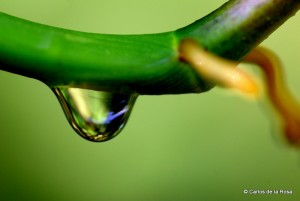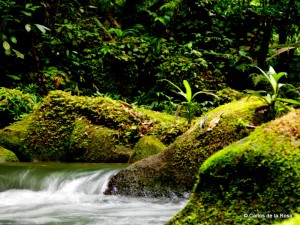 It is May, one of the hottest months at La Selva. It is also the beginning of the “rainy season” although calling this a “season” is a bit misleading. Perhaps we can call it the intensification of the rains, or the period when rains are more frequent and intense. Regardless, it rains in the rain forest, a lot, most of the time, and this means things are usually wet. Dig a few inches into the leaf litter and you’ll find and feel the moisture, even on the driest, hottest day. Pull down a bromeliad leaf and you’ll likely get rewarded with a little shower of accumulated water. Walk through an abandoned cacao or coffee plantation, now covered with a vibrant secondary forest, and you’ll see palm bracts and large leaves filled with water, miniature ponds of life. The creeks run continuously, swelling and ebbing with the rains. And this wetness, this high humidity provides a layer of moisture that holds things together, providing a nurturing substrate for all kinds of life to emerge. Entering this world, you enter the realm of the wet and sticky, starting with your clothes, soaked in a few minutes with perspiration. Your face and arms sweat, you brush the abundant vegetation and the accumulated moisture melts with your sweat, until you are drenched, dripping, sticky.
It is May, one of the hottest months at La Selva. It is also the beginning of the “rainy season” although calling this a “season” is a bit misleading. Perhaps we can call it the intensification of the rains, or the period when rains are more frequent and intense. Regardless, it rains in the rain forest, a lot, most of the time, and this means things are usually wet. Dig a few inches into the leaf litter and you’ll find and feel the moisture, even on the driest, hottest day. Pull down a bromeliad leaf and you’ll likely get rewarded with a little shower of accumulated water. Walk through an abandoned cacao or coffee plantation, now covered with a vibrant secondary forest, and you’ll see palm bracts and large leaves filled with water, miniature ponds of life. The creeks run continuously, swelling and ebbing with the rains. And this wetness, this high humidity provides a layer of moisture that holds things together, providing a nurturing substrate for all kinds of life to emerge. Entering this world, you enter the realm of the wet and sticky, starting with your clothes, soaked in a few minutes with perspiration. Your face and arms sweat, you brush the abundant vegetation and the accumulated moisture melts with your sweat, until you are drenched, dripping, sticky.
It is not a bad feeling, mind you. It is just that you are wet through and through, and feel like another humble creature wondering the forest looking for sustenance and avoiding being eaten, beaten or bitten. Everywhere you look, something is sticking to something else. Leaves stick to each other as they fall, held by the surface tension of the water. Almost immediately, fungi begin to grow in this moist layer. The rotting leaf decays faster and faster, the moisture providing the moisture and the leaf nutrients to a cadre of fungi, followed by algae, mosses, lichens and whatnot. Leafs skeletonize, losing all their soft tissues in a few days, leaving the harder, lignin-rich veins to decompose slower. These leaf skeletons are small works of art that one can literally peel off green leaves or the broad root of a tree.
Even green leaves amass this surface life, a variety of species that live phoretically on other plants, and even on animals. Large green palm leaves begin to grow mosses and lichens very quickly in the forest, turning into tiny forests themselves where ants roam, mites and tiny flies live and fungi and bacteria provide food for them. Orchid leaves turn into patches of color, orange, white, yellow, gray, lichens growing on the long-lived surface. Even exposed cement, like our forest trails “sidewalks,” become “naturalized” by this coating of life, becoming slippery, spongy and very alive. Insects, such as katydids, crickets, grasshoppers and even a few moth caterpillars have evolved to mimic these surfaces, blending in and disappearing into the background. Algae grow on the fur of sloths providing a habitat for a commensal moth species, a unique and bizarre relationship brokered by the constant moisture.
Some plants have evolved “drip tips” which help them channel excess moisture off them and shed some of this burden. But life is too pervasive, too intense, even aggressive, and it will take advantage and take root everywhere moisture allows it to do so. Water collects, runs, travels. From the leaden clouds to the top of the tallest trees, it hits the surface of the canopy and slides down, along leaves, branches, trunks, dripping, streaming, in drips and torrents, collecting nutrients, pollen, spores, seeds, eggs, larvae, micro- and macro-organisms. It fills tree holes and bromeliad axils that become aerial ponds, freshwater ecosystems in their own right, with their particular and peculiar flora and fauna. It collects in the sponge-like surface of tall branches, allowing enormous aerial gardens to form and flourish high up in the air. It also evaporates and condenses again, a fog that envelopes the trees, and that rises slowly at dawn and dissipates in the warmer layers of the air above the forest. The forest water is a river that runs vertically, from the canopy to the forest soil, and along the way, it detours, pauses, collects and releases, cycles and nurtures, and the forest thrives.
 After a day walking in the forest, I come out of it wet, sticky, with the feeling that I’ve just barely escaped with my life, still excited and enchanted by the experience, but a little desperate for a breather from the intensity of the encounters . I smell different, “organic,” maybe even a little feral. I carry in my skin and clothes pollen and spores, bits of leaves and a few insect parts, threads of spider webs and shreds of detritus. My knees and elbows have collected organic matter and mud from the forest floor where I have kneeled or lied down to capture a photo of a low-lying creature. My boots are heavy with the accumulated clumps of mud. My camera is loaded with images; my notebook brims with notes and flattened specimens, a butterfly wing, a skeletonized leaf, its pages softened by the constant cycles of wet and dry. My pockets carry seeds, or small fruits, or a plastic bag with a specimen to identify or photograph under more controlled conditions. I have become a little part of the ecosystem, wet, sticky, organic. And I can’t wait to do it all over again.
After a day walking in the forest, I come out of it wet, sticky, with the feeling that I’ve just barely escaped with my life, still excited and enchanted by the experience, but a little desperate for a breather from the intensity of the encounters . I smell different, “organic,” maybe even a little feral. I carry in my skin and clothes pollen and spores, bits of leaves and a few insect parts, threads of spider webs and shreds of detritus. My knees and elbows have collected organic matter and mud from the forest floor where I have kneeled or lied down to capture a photo of a low-lying creature. My boots are heavy with the accumulated clumps of mud. My camera is loaded with images; my notebook brims with notes and flattened specimens, a butterfly wing, a skeletonized leaf, its pages softened by the constant cycles of wet and dry. My pockets carry seeds, or small fruits, or a plastic bag with a specimen to identify or photograph under more controlled conditions. I have become a little part of the ecosystem, wet, sticky, organic. And I can’t wait to do it all over again.
Carlos de la Rosa

Recent Comments